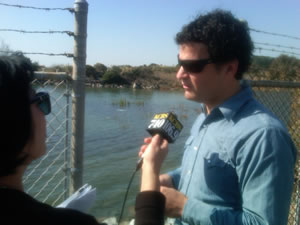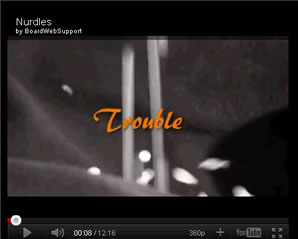Pacific Southwest, Region 9
Serving: Arizona, California, Hawaii, Nevada, Pacific Islands, Tribal Nations

Government Ordered Cleanup of Illegally Discharged Plastic Pellets will Protect San Francisco Bay, Endangered Species
Release Date: 10/28/2011
Contact Information: Dave Clegern, SWRCB, (916) 327-8239 or Mary Simms, U.S. EPA, (415) 947-4270, Simms.Mary@epa.gov
San Leandro, Calif. – The San Francisco Bay Regional Water Quality Control Board (Regional Water Board), State Water Resources Control Board (State Water Board) and U.S. Environmental Protection Agency have launched a first-in-the-nation enforcement effort to eliminate the discharge of pre-production plastic into the waters of California. The collaborative enforcement effort is being done under the authority of the State Water Board's Statewide Industrial Stormwater Permit. The first environmental cleanup ordered as a result of this joint effort is underway in San Leandro.
"This collaborative effort is part of a new front in the battle against plastic debris and trash," said Bruce Wolfe, Executive Officer of the SF Bay Regional Water Board. "Stormwater runoff is becoming a large part of our enforcement focus, because it affects water quality in every part of our region, and the state."
"Nurdles may sound harmless, but these small plastic pellets can do great damage to waterbodies like San Francisco Bay," said Jared Blumenfeld, EPA's Regional Administrator for the Pacific Southwest. "To protect our water resources, EPA is partnering with the State to require manufacturers to take steps to prevent pellet spills."
Pre-production plastic pellets are often called "nurdles". They are very small and contribute to the growing problem of plastic debris in inland and coastal waters of California and the U.S. Nurdles are often discharged into the environment while being unloaded from railcars at plastic manufacturing facilities, or being handled at those operations. They then wash into storm drains and out to open water with storm runoff. Spilled nurdles and other small pieces of plastic are eaten by fish, birds and other marine life. The plastic does not break down quickly, displaces food in the animals' stomach, and can lead to starvation.
Oyster Bay Regional Shoreline in San Leandro is the site of the first cleanup ordered because of the collaborative effort between state and federal environmental agencies. Surprise inspections at four plastic manufacturers resulted in the discovery of nurdles discharges from those facilities. Some of those discharges ended up in endangered species habitat at Oyster Bay.
The cleanup area includes habitat for both the endangered California Clapper Rail and Salt Marsh Harvest Mouse. The contracted cleanup crew will therefore do its work during the lunar high tide, when the animals will have moved to higher ground and the plastic debris will float to the surface. The nurdles and other debris will be swept up in large, floating pool skimmers, collected and hauled away. The work will be carried out under the guidance of a qualified Biological Monitor.
The Oyster Bay cleanup has been ordered under a cleanup and abatement order issued by the Regional Water Board. It is being paid for by the four companies responsible for the plastic discharges.
Similar inspections of plastic manufacturing facilities are being carried out around the Bay Area and in southern California.
A media availability is scheduled today at noon at the Oyster Bay Regional Shoreline in San Leandro, the site of the first cleanup resulting from this collaborative enforcement effort. The availability will begin at the main entrance to the Shoreline at the end of Neptune Drive. Members of the inspection team and cleanup effort will be available, as well as SF Bay Regional Water Board Executive Officer Bruce Wolfe and EPA Regional Administrator Jared Blumenfeld. They can discuss the cleanup now underway and the future of the joint effort.
- A video "back story" on the inspection and cleanup effort
- Downloadable raw video and sound from the clean up
- The Cleanup and Abatement Order
PLEASE NOTE: The Oyster Bay cleanup is taking place in the habitat of several endangered species. Their habitat is fragile and these creatures will be on the move because of both the high tide and presence of the cleanup crew.
It is essential that reporters and video crews stay on the paved trail to leave these animals as undisturbed as possible. The paved trail is adjacent to and above the cleanup area and will provide a good view of the activity.
RSVP: Please RSVP in advance with name, contact info (include email and phone) and media affiliation to Mary Simms at simms.mary@epa.gov to participate and discuss the best opportunities for coverage.
Directions: The media availability will be at the Oyster Bay Regional Shoreline, at the end of Neptune Drive in San Leandro. To get there from 1-880 in San Leandro, exit at Marina Blvd. and drive west. Turn right onto Neptune Drive. Parking is at the end of Neptune Drive.
-------------------
Mary Simms
Press Officer|U.S. Environmental Protection Agency
t: 415.947.4270, e: Simms.Mary@epa.gov
At LinkedIn: Mary Simms
| Pacific Southwest NewsroomPacific Southwest Programs | Grants & FundingUS-Mexico Border | Media Center Careers | About EPA Region 9 (Pacific Southwest)A-Z Index |


